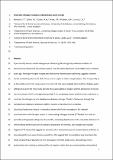Anaerobic nitrogen cycling on a Neoarchean ocean margin
Abstract
A persistently aerobic marine nitrogen cycle featuring the biologically mediated oxidation of ammonium to nitrate has likely been in place since the Great Oxidation Event (GOE) some 2.3 billion years ago. Although nitrogen isotope data from some Neoarchaean sediments suggests transient nitrate availability prior to the GOE, these data are open to other interpretations. This is especially so as these data come from relatively deep-water environments that were spatially divorced from shallow-water settings that were the most likely sites for the accumulation of oxygen and the generation of nitrate. Here we present the first nitrogen isotope data from contemporaneous shallow-water sediments to constrain the nitrogen cycle in shallow Late Archaean settings. The BH-1 Sacha core through the Campbellrand-Malmani carbonate platform records a transition from a shallow siliciclastic/carbonate ramp to a rimmed carbonate shelf with the potential for reduced communication with the open ocean. In these settings nitrogen isotope δ15N data from sub- to peri-tidal and lagoonal settings are close to 0‰, indicating diazotrophy or the complete utilization of remineralised ammonium with an isotopic composition of near 0‰. Our dataset also includes negative δ15N values that suggest the presence of an ammonium pool of concentrations sufficient to have allowed for non-quantitative assimilation. We suggest that this condition may have been the result of upwelling of phosphorus-rich deep waters into the photic zone, stimulating primary productivity and creating an enhanced flux of organic matter that was subsequently remineralised and persisted in the dominantly anoxic Neoarchaean marine environment. Notably, we find only limited evidence of coupled nitrification/denitrification, even in these shallow water environments, calling into question previous suggestions that the Late Archaean nitrogen cycle was characterized by widespread aerobic nitrogen cycling. Rather, aerobic nitrogen cycling was likely spatially heterogeneous and tied to loci of high oxygen production while zones of shallow water anoxia persisted.
Citation
Mettam , C W , Zerkle , A L , Claire , M , Prave , A R , Poulton , S W & Junium , C K 2019 , ' Anaerobic nitrogen cycling on a Neoarchean ocean margin ' , Earth and Planetary Science Letters , vol. 527 , 115800 . https://doi.org/10.1016/j.epsl.2019.115800
Publication
Earth and Planetary Science Letters
Status
Peer reviewed
ISSN
0012-821XType
Journal article
Description
This study was supported financially by NERC Fellowship NE/H016805/2 (to AZ), NERC Standard Grant NE/J023485/2 (to AZ and MC), NSF EAR-1455258 (to CKJ).Collections
Items in the St Andrews Research Repository are protected by copyright, with all rights reserved, unless otherwise indicated.

